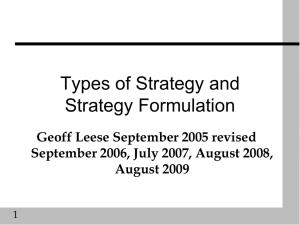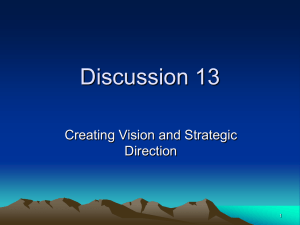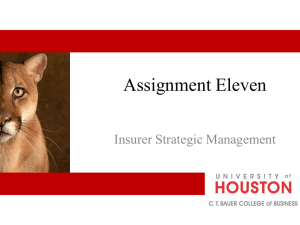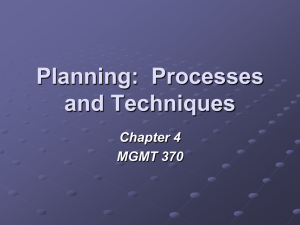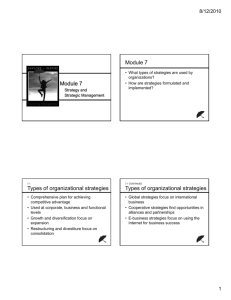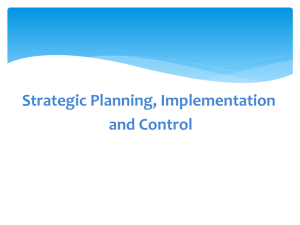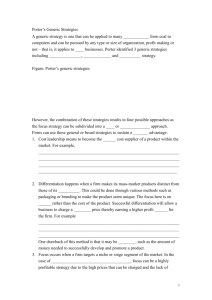Management 9e
advertisement
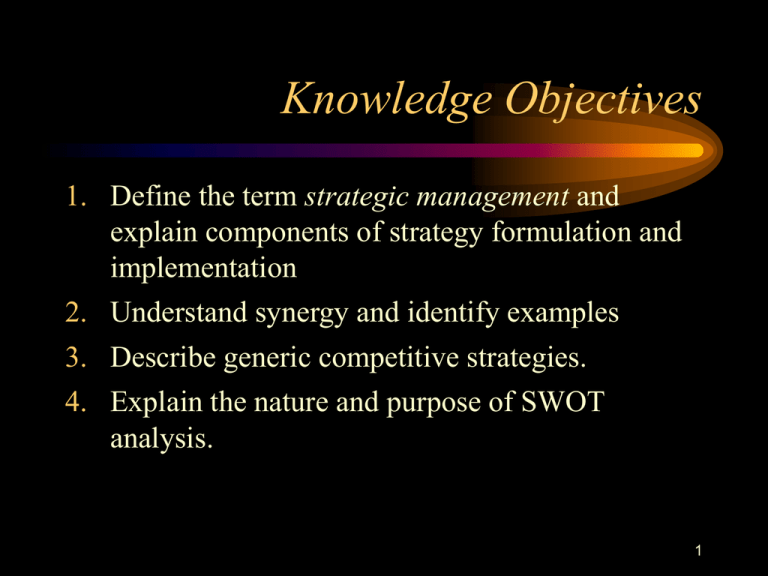
Knowledge Objectives 1. Define the term strategic management and explain components of strategy formulation and implementation 2. Understand synergy and identify examples 3. Describe generic competitive strategies. 4. Explain the nature and purpose of SWOT analysis. 1 Understanding Strategic Management • Strategic view helps frame decision making for other managers • Employees who think in strategic terms understand top management rationales • Trend is toward greater teamwork and cooperation throughout the planning cycle 2 Strategic Management = Strategic Planning + Implementation + Control • Strategic Management – Creating a fit between the organization and its changing environment. • Includes budget control, long-range planning, and strategic planning. • Merges strategic planning, implementation, and control to create a dynamic process. 3 Strategic Management = Strategic Planning + Implementation + Control (cont’d) • Strategy – An integrated externally-oriented perception of how to achieve the organization’s mission. • Strategic Planning – The process of determining how to pursue the organization’s long-term goals with resources expected to be available. 4 Thinking Strategically • Synergy – The whole is greater than the sum of the parts • Types of synergy – Market: extending products to new markets. – Cost: savings from combinations of commonbase operations, resources, and facilities (scope economies). – Technological: the transfer and application of technologies to new markets. 5 The Strategic Management Process • Steps in the Strategic Management Process 1. 2. 3. 4. Formulate overall strategy Formulate supporting strategic objectives Make implementation decisions Establish control systems 6 Porter’s Generic Competitive Strategies • Model’s Competitive Variables – 1. How to compete (cost vs. being unique) – 2. How broad is the target market • Cost Leadership Strategy – Lowest cost structure position - provides advantages in pricing, supplier negotiation • Differentiation Strategy – Unique/superior value position - provides brand loyalty. 7 Porter’s Generic Competitive Strategies (cont’d) • Focus Strategies – Variations on cost/differentiation but with a focus on narrow or regional market segment 8 Forecasting Techniques • Scenario analysis – Preparing written descriptions of alternative but equally likely future situations. • Longitudinal scenarios: describing how the future situations will evolve from the present. • Cross-sectional scenarios: describing future situations at a given point in time. 9 Thinking Strategically • The “Internet” World – There are still a lot of ways to make money on the Internet. – Customer loyalty is built with reliable brand names and “sticky” web sites. – Next Big Thing - Broadband/WiFi 10 Formulation • Which customers to serve?. • Identify Current & Future Competitive (dis)advantages – Find “fit” potential with SWOT (Strengths, Weaknesses, Opportunities, and Threats) • Assess likely competitive response(s) 11 Formulation • Identify, then perform competitive comparison of key capabilities, e.g. – – – – – Quick response to market trends. Rapid product development. Rapid production and delivery. Continuous cost reduction. Continuous improvement of processes, human resources, and products. – Greater flexibility of operations. 12 Formulation • Select option(s) • Formulate key objectives (Results-oriented, measurable objectives ) – – – – – Identify required activities Assign responsibilities Estimate time and sequencing of activities Determine required resources Lead, communicate, and coordinate the elements 13 Strategic Implementation • Implementation of Strategic Plans – Cascading the plan - shift to implementation & build middle-manager commitment 1. 2. 3. 4. new organizational structure(s) (reorient or replace) people. Culture (new?). Control systems. 14

